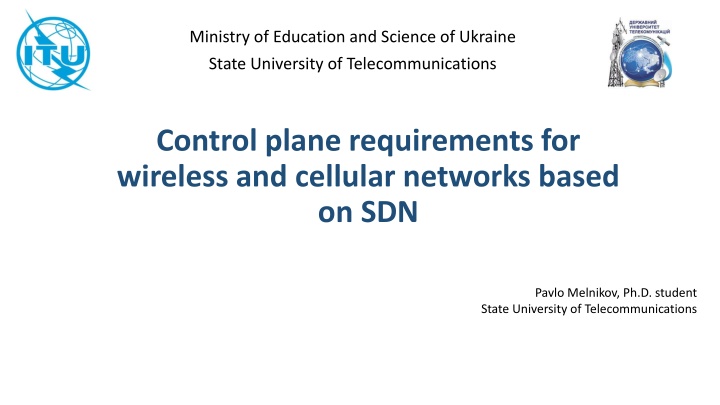
Control Plane Requirements for Wireless and Cellular Networks Based on SDN
"Explore the implementation of Software Defined Networking (SDN) in wireless and cellular networks, addressing current challenges, SDN architecture, system requirements, response delay analysis, and practical applications. Discover how SDN simplifies network control, enhances radio resource management, and streamlines mobility support across diverse technologies."
Download Presentation

Please find below an Image/Link to download the presentation.
The content on the website is provided AS IS for your information and personal use only. It may not be sold, licensed, or shared on other websites without obtaining consent from the author. If you encounter any issues during the download, it is possible that the publisher has removed the file from their server.
You are allowed to download the files provided on this website for personal or commercial use, subject to the condition that they are used lawfully. All files are the property of their respective owners.
The content on the website is provided AS IS for your information and personal use only. It may not be sold, licensed, or shared on other websites without obtaining consent from the author.
E N D
Presentation Transcript
Ministry of Education and Science of Ukraine State University of Telecommunications Control plane requirements for wireless and cellular networks based on SDN Pavlo Melnikov, Ph.D. student State University of Telecommunications
Content 1 Introduction 2 SDN Architecture 3 Appliance of SDN in context of wireless and cellular networks 4 System requirements 5 Response Delay analysis 6 Conclussion 2
Introduction Problems with Current Cellular Networks: - Plagued by complex and inflexible architecture - Most data plane related functionality centralized - Control plane too distributed e.g., radio resource allocation - No clear separation between control and data planes Too complex and inflexible 3
SDN Architecture Simplifying complexity in network control 4
Main terminology of SDN OpenFlow is the protocol which is used in software defined networks for communicating between SDN operational nodes. Can be used as a control and management protocol Control Plane is the layer of decisions applying an incoming and outgoing traffic through the network. Control plane packets are processed by the router to update the routing table information Data Plane is the layer which forwards traffic to the next hop along the path to the selected destination network according to control plane logic 5
Appliance of SDN in wireless and cellular networks Offers a logically centralized control plane - will lead to simpler and effective radio resource management (e.g., inter-cell interference management) Enables common control protocol across diverse wireless technologies - will ease seamless mobility support within and across technologies (e.g., 4G LTE, 3G UMTS, WiFi) Allows distributing traffic monitoring at switches deep inside the core network and ease the burden on the packet gateway 6
SDN and Openflow Use Case Appliance of SDN in control plane for receiving statistics data from wireless and cellular networks on: Physical (RSSI, Antenna Gain, Throughput), Data Link (MAC Addresses, Frame Counters), Network (IP addresses, subnetworks, Packet Counters), Transport (active TCP/UDP connections) Session (Number of active sessions (VoIP)) layers; 7
Requirements to the system Requirements to a control plane Response delay minimization Statistics gathering on enterprise servers for further analysis by administrator/system Scaling ability at increasing the number of end devices in a network 8
Request-Response delay Parts of a response delay 9
Response delay minimization To minimize response delay, we need to define bandwidth server and router delay 10
Response delay minimization The goal is to define Bandwidth-delay minimization which is introduced by a TCP Protocol Bandwidth x Delay = BDP 11
Server delay The goal is to define delay minimization introduced by a RAID5 disc array which is located on a server. After counting the number of read operations, which are made by read write requests, we can get an equation for an input intensity of disc requests Input intensity for request of one server disc 12
Network delay The goal is to define delay minimization which is introduced by a border router. The time nedded for router for datagram processing is called router delay and its value usually is represented by router manufacturer. The general time of message servicing on a router: Rts = Nd x Tdr , where Rts Router service time Nd number of datagrams Tdr Router delay (latency) 13
Use Case: network equipment statistics request using Openflow protocol Request Response switch(reqinfo->mode) { case MODE_GET: pthread_mutex_lock(&cambstats_mutex); switch(reginfo->handlerName[0]) { case '0': // 0 force_upd camb_stats_schedule_update(STATS_UPD_ATH_ETH); break; case '1': // 1 eth_rx_bytes param_64 = eth0_stats_res.rx_bytes >> 7; break; /*convert to KBit 8/1024 / case '2': // 2 eth_rx_packets param_64 = eth0_stats_res.rx_packets; break; case '3': // 3 eth_rx_errors param_64 = eth0_stats_res.rx_errors; break; case '4': // 4 eth_rx_drops param_64 = eth0_stats_res.rx_drops; break; case '5': // 5 eth_rx_multicast param_64 = eth0_stats_res.rx_multicast; break; case '6': // 6 eth_rx_broadcast param_64 = eth0_stats_res.rx_broadcast; break; case '7': // 7 eth_tx_bytes param_64 = eth0_stats_res.tx_bytes >> 7; break; /*convert to KBit 8/1024 / case '8': // 8 eth_tx_packets param_64 = eth0_stats_res.tx_packets; break; case '9': // 9 eth_tx_errors param_64 = eth0_stats_res.tx_errors; break; case 'A': // A eth_tx_drops param_64 = eth0_stats_res.tx_drops; break; case 'B': // B eth_tx_multicast param_64 = eth0_stats_res.tx_multicast; break; } 14
Conclussion Using SDN control plane for gathering and analyzing statistics data of terminal equipment, calculating the intensity of read requests disk arrays, reducing the request-response latency is beneficial for using in wireless and cellular networks. 15 15
Thank You! 16






